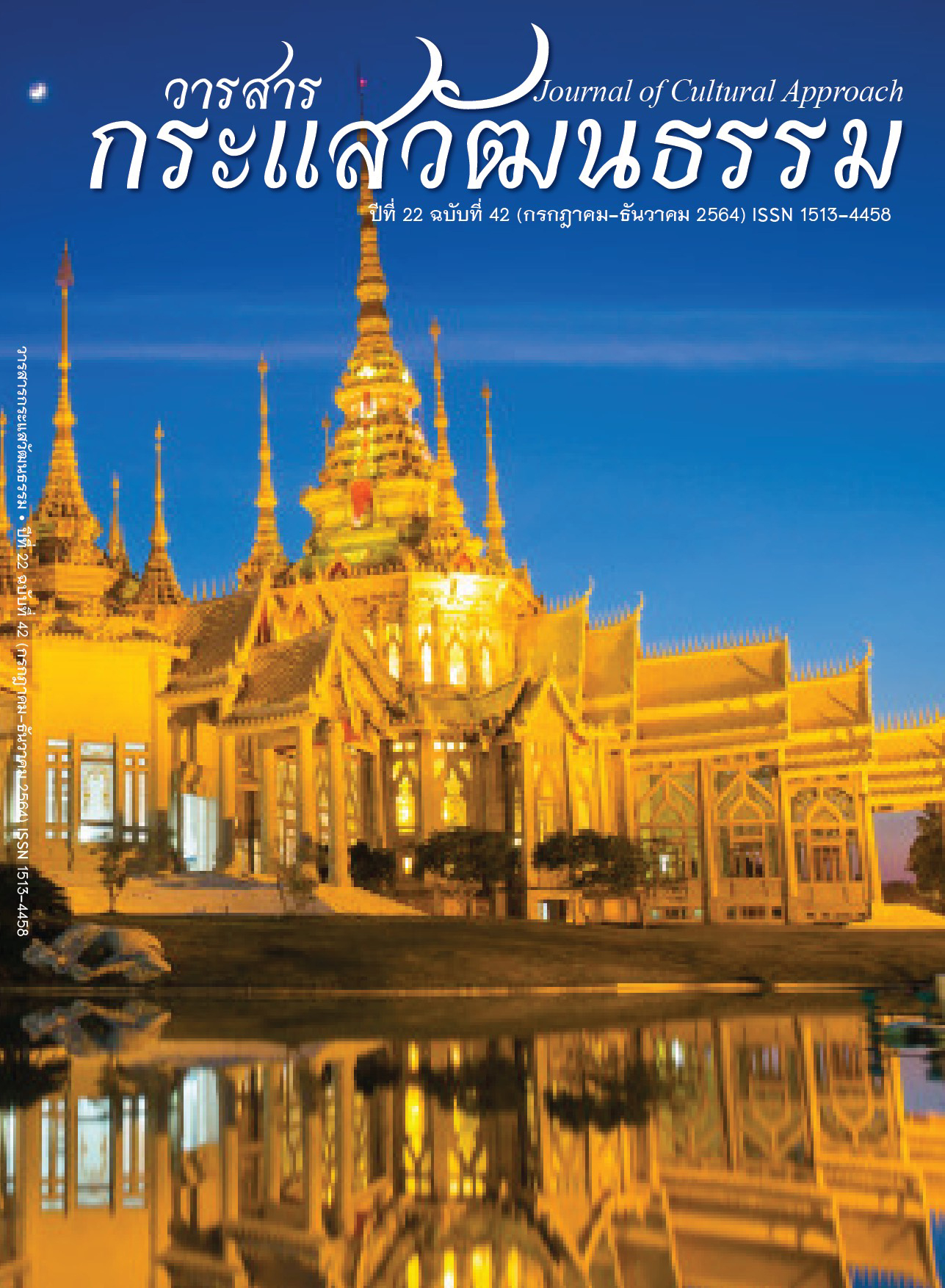แนวคิดและแรงบันดาลใจของการสร้างสรรค์นิทานและตัวละครเอกในนิทานวัดเกาะ “เทพสามฤดู”
Main Article Content
บทคัดย่อ
บทความฉบับนี้มีวัตถุประสงค์เพื่อศึกษานิทานวัดเกาะเรื่องสามฤดูฉบับ รศ. 108 และเทปละครเทพสามฤดูที่เผยแพร่ล่าสุดจำนวน 69 ตอน เพื่อวิเคราะห์แนวคิดและแรงบันดาลใจการสร้างสรรค์นิทานกับตัวละครเอก ผลการศึกษาพบว่ามีแนวคิดหลักตามขนบนิทานไทย และสอดคล้องกับคำสอนพุทธศาสนา ได้แก่ กรรม ความไม่เที่ยง ความทุกข์จากการพลัดพราก เป็นต้น การดำเนินเรื่องมีแบบแผนอย่างนิทานสากลที่มีแก่นเรื่องแนวประโลมโลก ตั้งแต่เริ่มต้นด้วยเหตุการณ์การเนรเทศพระโอรสยักษ์ราหูออกนอกเมืองทำให้เกิดการพลัดพรากระหว่างแม่และลูกนำไปสู่เรื่องราวการผจญภัยของตัวเอกโดยมีผู้ช่วยเหลือ การแสวงหาคนรักและครองคู่ซึ่งปรากฏแนวคิดเรื่องการสมพาสผิดธรรมชาติ และการปราบพญามารร้ายตามแนวคิดของธรรมะย่อมชนะอธรรม ส่วนตัวละครเอกเป็นเหล่าเทพเจ้าสามพระองค์ที่ได้รับบัญชาให้มาจุติในร่างมนุษย์เดียวกันและสลับกันปรากฏตัวตามการผันเปลี่ยนของฤดูกาล ได้แก่ พระราหู นางจินดาเมขลา และพระพิรุณ ซึ่งได้รับแรงบันดาลใจหนึ่งจากเทวตำนานและนิทานอธิบายเหตุธรรมชาติโดยมีแนวคิดการอวตารหรือการแบ่งภาค และบุคลาธิษฐานธรรมชาติจากการรวมกลุ่มตัวละครเทพที่สัมพันธ์กับปรากฏการณ์ธรรมชาติบนท้องฟ้า
Article Details

This work is licensed under a Creative Commons Attribution-NonCommercial-NoDerivatives 4.0 International License.
Proposed Creative Commons Copyright Notices
1. Proposed Policy for Journals That Offer Open Access
Authors who publish with this journal agree to the following terms:
- Authors retain copyright and grant the journal right of first publication with the work simultaneously licensed under a Creative Commons Attribution License that allows others to share the work with an acknowledgement of the work's authorship and initial publication in this journal.
- Authors are able to enter into separate, additional contractual arrangements for the non-exclusive distribution of the journal's published version of the work (e.g., post it to an institutional repository or publish it in a book), with an acknowledgement of its initial publication in this journal.
- Authors are permitted and encouraged to post their work online (e.g., in institutional repositories or on their website) prior to and during the submission process, as it can lead to productive exchanges, as well as earlier and greater citation of published work (See The Effect of Open Access).
Proposed Policy for Journals That Offer Delayed Open Access
Authors who publish with this journal agree to the following terms:
- Authors retain copyright and grant the journal right of first publication, with the work [SPECIFY PERIOD OF TIME] after publication simultaneously licensed under a Creative Commons Attribution License that allows others to share the work with an acknowledgement of the work's authorship and initial publication in this journal.
- Authors are able to enter into separate, additional contractual arrangements for the non-exclusive distribution of the journal's published version of the work (e.g., post it to an institutional repository or publish it in a book), with an acknowledgement of its initial publication in this journal.
- Authors are permitted and encouraged to post their work online (e.g., in institutional repositories or on their website) prior to and during the submission process, as it can lead to productive exchanges, as well as earlier and greater citation of published work (See The Effect of Open Access).
References
Aungthonggumnerd, C. (2013). The Avatar in Hinduism. Journal of Humanities, 20(1), 1-22.
Chaowlitprapan, P. (2006). Unnatural Sexual Relations in Thai Tale. Faculty of Arts, Chulalongkorn University.
Chotamra, L. (1969). Stories of Press, to Know to Laugh. Bangkok: Praepittaya.
Debyasuvarn, B. (1972). Transition of Thai Literature. Bangkok: the Promotion of Social Sciences and Humanities Textbook Project.
Dumsri, W. (1995). Folktale: Phra Rahu. San Nakhon Si Thammarat, 25(11), 89-97.
Griffith, R. (1973). The Hymns of Rig-Veda. Delhi: Motilal Banarsidass.
Intarawut, P. (1977). Hinduism and Iconography. Faculty of Archaeology, Silpakorn University.
King Mongkut, H. M. (1940). Drama: Sakuntala. Bangkok: Business Government of Organization.
King Mongkut, H. M. (1973). God and Things to Know. Bangkok: Dhambunnakan.
MacDonnell, A. A. (1981). Vedic Mythology. Delhi: Ideological Book House.
Na Thalang, S. (2016). Creative Folklore: Dynamics and Application of Folklore in Contemporary Thai Society. Bangkok: Princess Maha Chakri Sirindhorn Anthropology Centre.
Nimmanhaemin, P. (2008). Folktales Studies. Faculty of Arts, Chulalongkorn University.
Peerasathien, U. (1986). An Analytical Study of Tale Types and Motifs in Pannasa Jataka. Faculty of Arts, Chulalongkorn University.
Phisphumvidhi, P. (2005). Suriya Sasidhorn. Bangkok: Matichon.
Preyawanit, N. (2013). Deified Nature. NAJUA: History of Architecture and Thai Architecture, 10(suppl.), 210-233.
Prinoy, S. (2012). Mythology. Bangkok: Yipsee.
Raksamani, K. (2004). Mythological Tales. Bangkok: Maekumpang.
Rungruengsri, U. (1980). Vedic Mythology. Faculty of Humanities, Chiang Mai University.
Sujachaya, S. (2014). Literature of Thai Tale. Bangkok: Chulalongkorn University Press.
Thitathan, S. (1994). In Local, There are Many Stories and Games. Bangkok: Matichon.
Thompson, S. (1997). Folklore. London: University of California Press.
Tong, S. (2010). Siam Deva. Bangkok: Matichon.
Wattanamahat, K. (2003). Rattana Deveepakorn. Bangkok: Institute of Creative Books.
Yuyen, N. (2003). The Analysis of the Koh temple's principal female characters. Journal of the Faculty of Arts, Silpakorn University, 25(2), 65-107.

